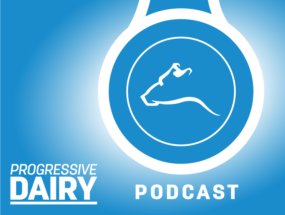We all know the old saying, “When life hands you lemons, make lemonade.” When it comes to milk in 2009, the market may be handing us the proverbial lemon. For many producers, milk prices may barely come near, let alone exceed, break-even levels. That certainly is the sour taste of a lemon.
So what can you do about a bad situation like this? You can attempt to make lemonade. What I will talk about isn’t what I would consider “normal” commodity marketing. Normal marketing is buying low, selling high and taking advantage of long-term trends. Even if the trends are not long-term, marketers under “normal” circumstances look at taking advantage of substantial and significant extended price moves like we’ve recently seen – first on the upside of milk and then on the downside.
As we look at 2009, it may indeed be necessary to make the best of a bad situation. If you look at the figure1, you can see in a very simplistic way how milk prices have dropped dramatically. There is a fair chance that, over the next year or so, milk prices will only see a moderate recovery back toward break-even levels, and then fall apart, followed by more recoveries back to approximately break-even levels, followed by more price breaks. This is what we call a volatile sideways pattern. Hopefully I’m wrong, and we’ll cull enough cows so that, ultimately, an uptrend is established. If not, it is going to be a tough year or two.
If prices are consistently only approaching or slightly surpassing break-even levels, your profit margins are going to be very minimal or non-existent. If it is going to be a tough time, let’s look at what could be done to make the most of it. The “lemonade recipe” that follows can best be described as “working the market.”
I believe that the best way to try to capitalize in this kind of a market situation is to watch these rallies up to the break-even area and use them to aggressively price. Hopefully the worst of the news is in, and the worst of the prices are behind us. Therefore, once you get priced and the market drops off fairly hard, the odds of downward follow-through and greater declines become quite limited. In that situation, it makes sense to lift hedges, take your chances on the market and wait for a recovery.
When prices do recover, once again realize that upside potential is pretty limited; downside risk is much greater than upward potential and recognize it is time to get priced again. You are now, in a strategic, structured way, “working the market.”
Yes, this approach could be considered a bit aggressive. I suppose a person could even argue that it is somewhat speculative, but quite frankly, in a sideways market, there aren’t many choices. When it comes to hedging versus speculation, you can argue all day long about what is right or wrong. The bottom line is this: If at the end of the year you are profitable and in business, then you’ve done so with a calculated, structured approach to your marketing. You can feel good about your business and its future.
I’ve talked about a potential approach to marketing your milk, but I would be remiss if I did not mention what the grain markets are doing. The viability of your business depends on your ability to both purchase feed and market milk in concert, with an eye on the operating margin. Depending on crop size this year, and considering the deflationary environment that we are currently in, grain prices could follow choppy sideways patterns similar to milk.
Your approach to pricing your feed inputs should be just the opposite of your milk pricing. When prices dip to the bottom end of the range and in the vicinity of previous lows, get your feed priced. However, after an initial run-up, the upward potential from there becomes quite limited unless there are some significant crop problems in the fields across the Midwest. At that point, upward potential becomes limited, and it is time to lighten up or exit your hedges and look to re-establish back down near the lows. If you want to be a little more conservative, stay long-hedged with stops on your orders to trigger you out should the market move lower.
The theme of the market over the past few years, and certainly in the years ahead, is continued volatility. You have to embrace this volatility and be prepared to manage it and capture it. Otherwise, volatility is going to be your nemesis.
One theme I always come back to is this: Don’t get set in your thinking on “what the market is going to do.” An outlook-based approach to marketing can be very limiting and also quite costly. In this article I’ve talked about a possibility of how the market may perform in the months ahead, but don’t anticipate that this is set in stone. You should always have contingency plans in place. That way, you will know how you will manage your milk marketing and feed purchases should an uptrend be established in either sector, or how you are going to manage both if a downtrend and new lows are established. You should always have strategies outlined for small moves up, large moves up, small moves down and large moves down. That is what a dynamic, strategic approach to marketing is all about, and that is what is necessary to survive and prosper in today’s marketplace.
Finally, consider this: Knowing your marketing strategies and having a decision-making process in place will not only help you approach the marketplace with confidence, but it also will help your lenders have confidence in you. Lenders know we are in for continued volatility. Those we have talked with tell us that their producer clients who have a structured, disciplined approach to marketing are feeling better about this downtrend than those who do not. All of your advisers, whether financial, marketing or production-related, should be in tune with the goals you have for your operation. With this team of advisers in place, you will not only be “working the market” during tough times, but you’ll have marketing that works – long-term. PD
Scott Stewart
President and CEO
Stewart-Peterson
scotts@stewart-peterson.com




